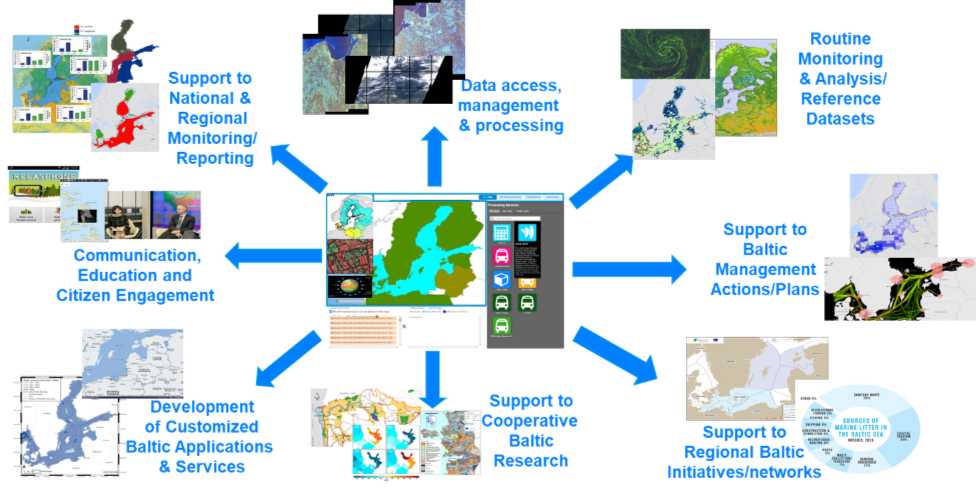The aim of the Baltic Initiative Applications element is to embed EO-derived information into pre-operational regional monitoring, assessment and planning activities. This includes enhanced environmental monitoring and assessment, improved management of natural resources in the region, support to regional programmes in the fields of economic development, civil security and climate resilience across the following domains:
-
- Enhanced common MFSP/WFD/MSP monitoring & assessment combined with EO based territorial planning and ecosystem based approaches.
- Improved natural capital/ecosystems monitoring & assessment.
- Address gap in characterizing ecosystem regulating and supporting services.
- Regional approach for status mapping for key natural resources.
Currently the basic scope of the environmental monitoring in the basin in based on in situ systems (sensors, surveys) being deployed at the Baltic to measure and monitor various physical and chemical parameters like water temperature and pressure, wind direction and speed, salinity, turbidity, pH, oxygen density, and chlorophyll levels including via sensor mounted on board of the vessels. Moreover, local authorities from the cities around the Baltic Sea Region are increasingly reliant on in situ observations and analytics to collect data that can help them address their social, economic, and environmental challenges (i.e. urban mapping and analytics, analysis of mobility data, MNO – mobile networks operator data, etc.). In the same mode, agriculture sensor networks expand rapidly in agricultural equipment such as tractors and farm implements and a range of low-powered ground sensors are being used to support precision agriculture and smart farming by providing localised information about humidity, temperature, soil moisture, crop health, etc. All these data streams bring real opportunity to develop a next generation integrated services taking advantage of the combination of EO monitoring at scale and in situ sensors for modelling and validation.
The scope of the Baltic Initiative is to address the EU policies, national and regional strategies as well as priorities related to the sustainable development of economic sectors in the basins through the territorial and marine spatial planning taking into account environmental, agriculture, transport, energy, and urban development dimensions. What is at focus in particular are land-sea interactions, agri-environmental issues (crop production, fertiliser use, livestock operations), coastal infrastructure (aquaculture, energy infrastructure), coastal urbanization monitoring and impact assessment, as well as water quality monitoring and pollution transport pathways.
Moreover addressing emerging priorities of the Baltic Marine Environment Protection Commission, also known as the Helsinki Commission (HELCOM), is at the forefront of the Initiative. The HELCOM has been a custodian of the regional strategic and regulatory perspectives in the region and an intergovernmental organization responsible for the implementation of the Convention on the Protection of the Marine Environment of the Baltic Sea Area. Today, since the agreement of the regional Baltic Sea Action Plan (BSAP), HELCOM is in charge of the definition of a range of the monitoring protocols, coordination on the regional level and stimulating cooperation and innovation. The current BSAP focus is on eutrophication, hazardous substances, maritime activities and biodiversity. The definition of the future BSAP (2021 forward) will include additional topics such as:
- Preventing and mitigating operational pollution from ships particularly in exhaust emissions and sewage as well as monitoring of chemical pollution, oil spills (and spill response) and associated risk assessments, and re-surveys
- Implementation of the ecosystem-based approach in fisheries and aquaculture including protection of biodiversity, and Marine Protected Areas
- Impact of other economic activities on Baltic ecosystem such as offshore wind power developments, underwater pipelines and cables, offshore oil and gas, submerged hazardous objects and leisure boating,
- Climate change impacts,
- Future scenarios around maritime traffic.

